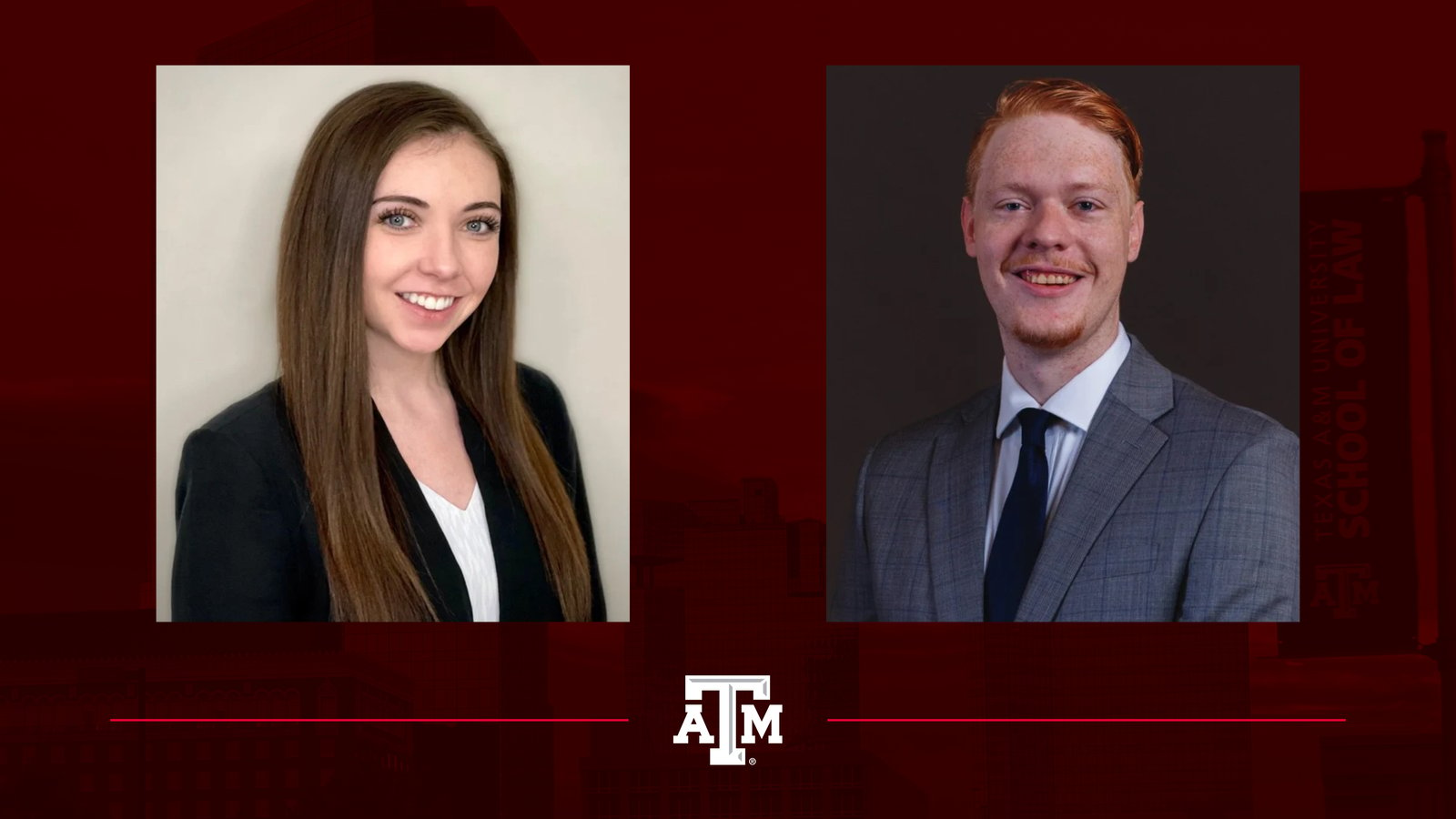Day Five – The Journey South: Tel Aviv to Mitzpe Ramon
By: Carolyn Wheeler '25 and Matthew McGrenera '25
This article is part of a series of reflections prepared by students enrolled in the Texas A&M School of Law 2023 Global Field Studies Program: Israel. Click here to visit the entire series.
The professors had warned us the night before that Thursday would be one of the longest, busiest days of the trip. While this was definitely true, it was also one of the most rewarding days of the trip.
We started our day with a quick breakfast followed by checking out of our hostel in Tel Aviv. We traveled south to Rahat, an orchestrated Bedouin village equipped with the infrastructure needed for access to water, wastewater management, garbage disposal, etc. Within Israel, Bedouin villages are categorized into three groups. Orchestrated villages are developed by the Israeli government. Recognized villages are Bedouin-developed villages that are legally recognized by the Israeli government but lack infrastructure. Lastly, unrecognized villages are Bedouin-developed villages that are not recognized by the Israeli government and are technically illegal meaning they can, in theory, be demolished at any time. As we traveled South, the landscape quickly began to change as we traveled South. The amount of vegetation decreased more and more the further we entered into the Negev Desert. By the time we reached Rahat, it looked like we were in a whole different world. Tel Aviv was full of trees and grass. The Negev Desert is a hyper-arid environment lacking almost all trees and grass entirely. Shockingly, we learned that for every drop of rainwater that falls here, twenty evaporate. Incredibly, this was only about an hour's drive. In the village, we met Layla Al-Sana, CEO of Naqab Media, who led us throughout the day. Layla was very passionate about her Bedouin identity. Her eagerness to tell us about her way of life and the challenges she and other Bedouins were facing was immediately clear. Layla was our first encounter with the Bedouin people that we had heard so much about. In Tel Aviv, we had heard many mixed opinions about the Bedouins and their way of life. But upon meeting Layla and seeing Rahat, one thing was absolutely clear: they were people just like the rest of us.
On the way to visit a wastewater treatment facility, we stopped at an overlook where Layla explained that the area is a dry creek bed that used to flow to Gaza from the rare rainfalls. Now, a dam has been installed to capture that flow for nearby irrigation, and the groundwater in the area is contaminated. She also told us there was no effective waste management system in the region outside the boundaries of Rahat and that trash often ends up thrown in the creek valleys. We were all struck and disturbed by the amount of plastic that filled the creek bed through which the most precious resource of the region flowed.
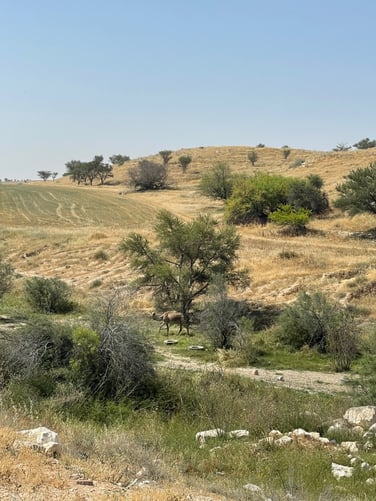
We also saw wild camels for the first time at this stop—one was even bellowing!
We then reached the regional wastewater treatment facility where we met representatives from the local water corporation and local council members: Mnsoor Siam from the water corporation, Mazen Abu Siam from the Council’s Public Health Department, and local resident Naofaf Zayadne. They explained to us that their treatment process is similar to that we saw at the Shafdan plant, but on a smaller scale. Water treated here was then used for agriculture, and the sludge was converted to fertilizer. They said they hope to expand this plant to meet the region’s growing needs and demand. Seeing this wastewater treatment plant and learning that it was not constructed or intended to treat the water of any of the Bedouin villages that surrounded Rahat was a harsh reminder that not all areas of Israel have access to the type of facilities that we saw in Tel Aviv. The conversation we had with Mnsoor Siam was another reminder of the intense cultural tensions facing Israel. One of the workers from the treatment plant was adamant that the conversation not be a political one. Layla interjected several times suggesting that this conversation was impossible to have without partially addressing the politics. Layla repeatedly reminded us and the worker of the treatment plant that this plant did not treat everyone's wastewater and that it seemingly ignored the Bedouin villages surrounding Rahat. It started to become clear that perhaps this was an attempt by the Israeli government to force the Bedouins into Rahat. However, the worker of the treatment plant was adamant that the villages around Rahat not be a part of our conversation. A conversation, about sewage of all things, showed us just how intertwined politics is with every aspect of Bedouin life. It was clear that this conversation included people with very different views. Despite this, we were still able to learn from both parties. It became clear that the Israeli government viewed the orchestrated villages very differently than the unrecognized Bedouin villages.
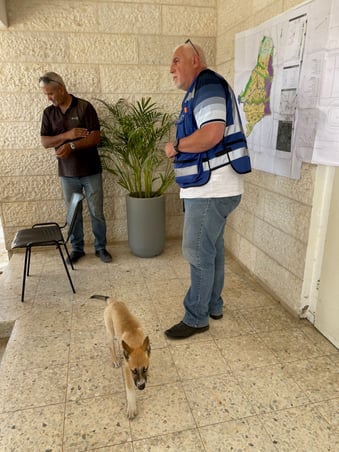
The conversation with a worker at the treatment plant featuring the facilities resident dog.
Afterwards, we stopped at Al-Fura'a, an unrecognized Bedouin village where we learned more about the Bedouin culture, including their leadership structure. We also saw that this village utilizes solar power. Layla noted that while this system works well during sunny desert days, the village has no electricity access when it is cloudy and at night. Furthermore, the local water tank had caused some disputes in the community because the community itself had to pay for the pipes to be installed from the tank servicing Rahat into their village. The water meter is also located at the tank, meaning that the entire village was billed for water as if it were one user, which made their water bill incredibly high due to Israel’s tiered fee structure that charges higher rates for the use of greater amounts of water. After hearing so much about unrecognized Bedouin villages before this, it was incredibly eye-opening and humbling to step foot in one and see truly what these villages are like.
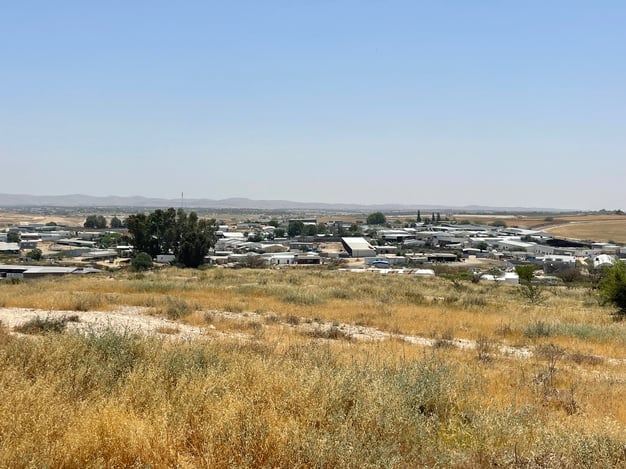
The view from the top of the hill above an unrecognized village in the area surrounding Rahat.
Next, we traveled to have lunch in Rahat. We met Husniya Even Beri, a Bedouin woman who runs a local tourism initiative called Husniya’s House. Through Husniya’s House, she welcomes groups into her home to share her story and her perspectives on the relationship between Bedouins and Israelis, gender roles in Bedouin culture, and how she is helping local entrepreneurs by selling their goods at Husniya’s House. It was inspiring to learn how she grew into a strong woman and leader, despite the odds being against her. After our lunch and discussion, we were able to look through the local entrepreneurs’ goods to purchase.

Inside Husniya’s House as we learned about her story and prepared for an amazing lunch.
We then traveled to meet with Attia Al-Asam, the Head of the Council of Bedouin Unrecognized Villages in the Negev. Mr. Al-Asam echoed the things that Layla had told us throughout the day and explained the complexity of a community that is tribal in nature but exists under one title, the Bedouins. It was clear that Mr. Al-Asam had a strong desire to help the unrecognized villages. However, he was very doubtful that any of this help would come from the government. He said that Israel had let the Bedouins down before and there was nothing to suggest that this would change. Lastly, Mr. Al-Asam and Layla explained why the people in the unrecognized villages stay in such harsh conditions rather than move to a recognized village. Coming from a place so far removed from this culture, this question was something we were all wondering. Ultimately, the answer is one of tradition. It is not that the Bedouin people just “want to be difficult” or “stick it to the Israeli government.” Rather, it is that these families have a deep connection to the land they are on and would rather live without the basic comforts we take for granted than to give up this connection. This was further evidence that this connection to the land went much deeper than we could expect or even understand.
Our last stop for the day was a school in Al Fura'a where thousands of students are taught. Here we met Fareed Mahameed, an environmental public health specialist and Assistant Director of the Arava Institute's Center for Transboundary Water Management. The first thing we were told as we exited the bus to enter the school was, “I hope you have your water bottles filled up, we don’t have drinking water here.” It was shocking that a school in the middle of the Negev Desert was unable to provide its students and teachers with water to drink throughout the day. Fareed talked to us about his experience teaching in the school and what this school meant to the students and communities that relied on it. It became clear to us, once again, just how essential education was to all of the communities living in Israel. Fareed told us there are 36 unrecognized Bedouin communities, 11 recognized communities, and 7 orchestrated communities in the Negev. Bedouins make up one-third of the Negev population, but the Bedouins have only around 3% of the Negev land. Fareed told us about the challenges unrecognized villages faced with demolition by the Israeli government. Fortunately, the school is safe from demolition because it is recognized as Israeli law ensures access to education for all. However, this does not mean that the infrastructure to treat the school’s wastewater is also recognized. Because of this, anything surrounding the school (that is not the school itself) must be moveable or risk being demolished.
Throughout the trip, we had been working with Clive Lipchin who developed a system of decentralized wastewater. At the school, we were finally able to see Clive’s invention (the Laguna system) in action. The school relies on the Laguna system to treat its wastewater. Previously, the school had to use cesspits as many of the unrecognized villages do. Fareed explained to us that because the Laguna system could be loaded into a truck and moved, it was completely legal. However, the concrete slab that the system was placed on was illegal and therefore could be destroyed. Despite this, the Laguna system seemed to be the only option for the school to treat its waste without the government demolishing all of its efforts.
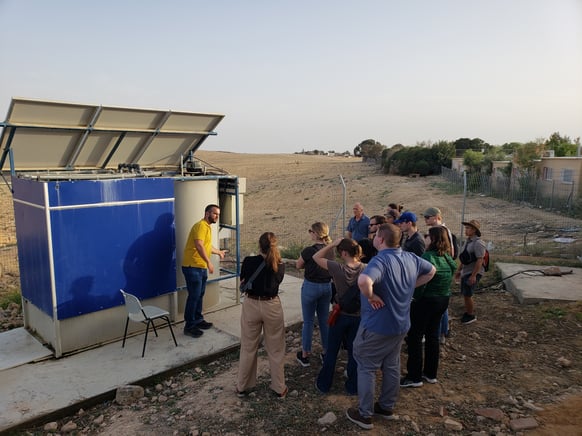
Fareed Mahameed explains how the Laguna system has benefited the school.
Our long day came to an end with a drive to our hostel located just outside a small city in the Negev, Mitzpe Ramon. Now completely engulfed in the desert landscape, we stayed at this hostel for the next three nights. After a quick dinner in the hostel's dining room, we checked into our rooms, reflected on the fact that just that morning we were in a major, metropolitan city, and got some much-needed rest to prepare for a day of exploring Mitzpe Ramon.
Learn more about Texas A&M University School of Law's Global Law and Policy Program, Aggie Dispute Resolution Program, and Energy, Environmental, and Natural Resource Systems Law Program
